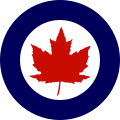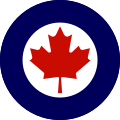Royal Canadian Air Force
The Royal Canadian Air Force (RCAF; French: Aviation royale canadienne, ARC) is the air and space force of Canada.[3] Its role is to "provide the Canadian Forces with relevant, responsive and effective airpower".[4] The RCAF is one of three environmental commands within the unified Canadian Armed Forces. As of 2020, the Royal Canadian Air Force consists of 12,074 Regular Force and 1,969 Primary Reserve personnel, supported by 1,518 civilians, and operates 258 manned aircraft and nine unmanned aerial vehicles.[1][5] Lieutenant-General Eric Kenny is the current Commander of the Royal Canadian Air Force and Chief of the Air Force Staff.[6]
The Royal Canadian Air Force is responsible for all aircraft operations of the Canadian Forces, enforcing the security of Canada's airspace and providing aircraft to support the missions of the Royal Canadian Navy and the Canadian Army. The RCAF is a partner with the United States Air Force in protecting continental airspace under the North American Aerospace Defense Command (NORAD). The RCAF also provides all primary air resources to and is responsible for the National Search and Rescue Program.
The RCAF traces its history to the Canadian Air Force, which was formed in 1920. The Canadian Air Force was granted royal sanction in 1924 by King George V to form the Royal Canadian Air Force. In 1968, the RCAF was amalgamated with the Royal Canadian Navy and the Canadian Army, as part of the unification of the Canadian Forces. Air units were split between several different commands: Air Defence Command (ADC; interceptors), Air Transport Command (ATC; airlift, search and rescue), Mobile Command (tactical fighters, helicopters), Maritime Command (anti-submarine warfare, maritime patrol), as well as Training Command (TC).
In 1975, some commands (ADC, ATC, TC) were dissolved, and all air units were placed under a new environmental command called simply Air Command (AIRCOM; French: Commandement aérien). Air Command reverted to its historic name of "Royal Canadian Air Force" in August 2011.[7]
The Royal Canadian Air Force has served in the Second World War, the Korean War, the Persian Gulf War, as well as several United Nations peacekeeping missions and NATO operations. As a NATO member, the force maintained a presence in Europe during the second half of the 20th century.
History
[edit]1920–1945: Pre-unification
[edit]The Canadian Air Force (CAF) was established in 1920 as the successor to a short-lived two-squadron Canadian Air Force that was formed during the First World War in Europe. Wing Commander John Scott Williams was tasked in 1921 with organizing the CAF, handing command over later the same year to Air Marshal Lindsay Gordon.[8] The new Canadian Air Force was a branch of the Air Board and was chiefly a training militia that provided refresher training to veteran pilots.[9][10] Many CAF members also worked with the Air Board's Civil Operations Branch on operations that included forestry, surveying and anti-smuggling patrols.[11] In 1923, the CAF became responsible for all flying operations in Canada, including civil aviation. In 1924, the Canadian Air Force, was granted the royal title, becoming the Royal Canadian Air Force (RCAF). Most of its work was civil in nature, with forest patrols of the northwest a major part of its operations;[12] however, in the late 1920s other agencies took up most civil tasks, with the notable exception of aerial photography surveys, and the RCAF evolved into more of a military organization.[13] After budget cuts in the early 1930s, the air force began to rebuild.[14]: 47

Second World War
[edit]During the Second World War, the RCAF was a major contributor to the British Commonwealth Air Training Plan and was involved in operations in the United Kingdom, Europe, the north Atlantic, North Africa, southern Asia, and with home defence. Eight thousand, eight hundred and sixty-four Americans came north to volunteer for the RCAF and over 850 died in action.[15] By the end of the war, the RCAF had become the fourth largest Allied air force.[16] During World War II the RCAF was headquartered at a six-storey office building at 20-23 Lincoln's Inn Fields (built 1937), London.[17] A commemorative plaque can be found on the outside of the building.[18]
1945–1968
[edit]After the war, the RCAF reduced its strength. Because of the rising Soviet threat to the security of Europe, Canada joined NATO in 1949, and the RCAF established No. 1 Air Division RCAF consisting of four wings with three fighter squadrons each, based in France and West Germany. In 1950, the RCAF became involved with the transport of troops and supplies to the Korean War; however, it did not provide RCAF combat units. Members of the RCAF served in USAF units as exchange officers and several flew in combat. Both auxiliary and regular air defence squadrons were run by Air Defence Command. At the same time, the Pinetree Line, the Mid-Canada Line and the DEW Line radar stations, largely operated by the RCAF, were built across Canada because of the growing Soviet nuclear threat. In 1957, Canada and the United States created the joint North American Air Defense Command (NORAD). Coastal defence and peacekeeping also became priorities during the 1950s and 1960s.[14]: 245, 377
1968–present: Unification
[edit]
In 1968, the Royal Canadian Navy, Royal Canadian Air Force and Canadian Army were amalgamated to form the unified Canadian Forces. This initiative was overseen by the Defence Minister, Paul Hellyer. The controversial merger maintained several existing organizations and created some new ones: In Europe, No. 1 Canadian Air Group, operated Canadair CF-104 Starfighter nuclear strike/attack and reconnaissance under NATO's Fourth Allied Tactical Air Force; Air Defence Command: operated McDonnell CF-101 Voodoo interceptors, CIM-10 Bomarc missiles and the SAGE radar stations within NORAD; Air Transport Command: provided strategic airlift for the NATO and UN peacekeeping missions; and Training Command. Aviation assets of the Royal Canadian Navy were combined with the RCAF Canadair CP-107 Argus long-range patrol aircraft under Maritime Command. In 1975, the different commands, and the scattered aviation assets, were consolidated under Air Command (AIRCOM).
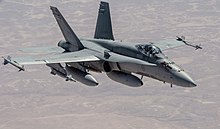
In the early 1990s, Canada provided a detachment of CF-18 Hornets for the air defence mission in Operation Desert Shield. The force performed combat air patrols over operations in Kuwait and Iraq, undertook a number of air-to-ground bombing missions, and, on one occasion, attacked an Iraqi patrol boat in the Persian Gulf.
In the late 1990s, Air Command's CF-18 Hornets took part in the Operation Allied Force in Yugoslavia, and in the 2000s, AIRCOM was heavily involved in the Afghanistan War, transporting troops and assets to Kandahar. Later in the decade-long war, AIRCOM set up a purpose-specific air wing, Joint Task Force Afghanistan Air Wing, equipped with several CH-146 Griffon and CH-147 Chinook helicopters, CC-130 Hercules, CU-161 Sperwer and leased CU-170 Heron UAVs in support of the Canadian Forces and ISAF mission. The wing stood down on 18 August 2011.
From 18 March to 1 November 2011, the RCAF was engaged in Operation Mobile, Canada's contribution to Operation Unified Protector in Libya. Seven CF-18 Hornet fighter aircraft and several other aircraft served under Task Force Libeccio as part of the military intervention.[19]
On 16 August 2011, the Government of Canada announced that the name "Air Command" was being changed to the air force's original historic name: Royal Canadian Air Force (along with the change of name of Maritime Command to Royal Canadian Navy and Land Force Command to Canadian Army). The change was made to better reflect Canada's military heritage and align Canada with other key Commonwealth countries whose military units use the royal designation.[20] The RCAF adopted a new badge in 2013, which is similar to the pre-unification RCAF badge (although placed in the modern frame used for command badges). The Latin motto of Air Command – Sic itur ad astra – which was the motto of the Canadian Air Force when first formed after the First World War (before it became the Royal Canadian Air Force in 1924) was retained. Though traditional insignia for the RCAF was restored in 2015, there has been no restoration of the traditional uniforms or rank structure of the historical service (apart from a rank of "aviator", which replaced that of "private" in 2015).[21]
On 17 April 2014, Prime Minister Stephen Harper announced that Canada was dispatching six CF-18s and military personnel to assist NATO in operations in Eastern Europe.[22]
Equipment
[edit]Aircraft
[edit]This section duplicates the scope of other articles, specifically List of active Canadian military aircraft. (April 2022) |
The Royal Canadian Air Force has about 430 aircraft in service, making it the third-largest air force in the Americas, after the United States Armed Forces, and the Brazilian Air Force.
Weapons and other equipment
[edit]Weapons systems are used by the CF-18 Hornet, CP-140 Aurora, CH-146 Griffon and the CH-148 Cyclone.
| Manufacturer | Origin | Weapon | Type | Entered service | Notes |
|---|---|---|---|---|---|
| Lockheed Martin | GBU-10 Paveway II (12, 16 and 24) | Laser-guided bomb | 1980s | Used by CF-18 | |
| General Dynamics | Mark 82 bomb | Low drag general-purpose bomb (500 lb (230 kg)) | 1970s | Used by CF-18 | |
| General Dynamics | Mark 83 bomb | Low drag general-purpose bomb (1,000 lb (450 kg)) | 1980s | Used by CF-18 | |
| General Dynamics | Mark 84 bomb | Low drag general-purpose bomb (2,000 lb (910 kg)) | 1980s | Used by CF-18 | |
| Boeing | Joint Direct Attack Munition[27] | A kit to convert a regular bomb into precision-guided munition | 2011 | Used by CF-18 | |
| Raytheon/Hughes | AGM-65G Maverick Missile | Air-to-surface missile | 1999 | Used by CF-18. First leased in 1999 from the United States for Kosovo Force, then purchased in 2002 for the War in Afghanistan (2001-2021)[28][29] | |
| Bristol | CRV 7 Rocket | Folding-fin ground attack rocket | 1970s | Used by CF-18 | |
| Douglas | AIM-7 Sparrow | Medium-range semi-active radar homing air-to-air missile | 1980s | Used by CF-18 | |
| Raytheon/Hughes | AIM-120 AMRAAM | Beyond Visual Range (BVR) air-to-air missile | 2000s | Used by CF-18 | |
| Raytheon/Ford/ Loral Corp. |
AIM-9 Sidewinder | Heat-seeking, short-range, air-to-air missile | 1980s | Used by CF-18 | |
| General Dynamics/ General Electric |
M61 20mm Vulcan cannon | Air-cooled gatling-style cannon | 1980s | Used by CF-18 | |
| Alliant | Mark 46 torpedo | Air and ship-launched lightweight torpedo | 1970s | Used by CP-140 Aurora and CH-148 Cyclone (but not by CP-140A Arcturus) | |
| FN Herstal | FN MAG C6 | 7.62 mm self-defence machine gun | 1980s | Used by CH-146 Griffon, CH-147F Chinook and CH-148 Cyclone | |
| Dillon Aero | M134 | 7.62 mm self-defence machine gun | 2011 | Used by CH-146 Griffon | |
| Browning Arms Company | M3M | 0.50 cal (12.7 mm) machine gun | 2013 | Used by CH-146 Griffon |
| Manufacturer | Origin | Name | Type | In Service | Notes |
|---|---|---|---|---|---|
| Systems & Electronics, Inc. | 60K Tunner | Material handling equipment | 2008 | Used with CC-177 transport | |
| JBT AeroTech | Halvorsen 44K Loaders | Truck Aircraft Side Load Unload (TASLU) Loader | 2008 | 4 for use with CC-177; licensed from Static Engineering of Australia | |
| Mobile Arrestor Gear | |||||
| FMC Corp. | B-1200 | Aircraft towing tractor | 2008 | Used to tow CC-177 and CC-130 |
Retired weapons
[edit]| Weapon | Country of manufacture | Type | In service | # |
|---|---|---|---|---|
| CIM-10 Bomarc-B | Supersonic missile equipped with a 10 kt W40 (nuclear warhead) | 1962 to 1972 | N/A | |
| AIR-2 Genie | Air-to-air rocket with a 1.5 kt W25 (nuclear warhead) | 1965 to 1984 | N/A | |
| MK-20 "Rockeye" | Cluster bomb | 1980s to 1997[30] | ≈1000 |
Structure
[edit]The commander of the Royal Canadian Air Force, at National Defence Headquarters in Ottawa, commands and provides strategic direction to the Air Force. The commander of 1 Canadian Air Division and Canadian NORAD Region, based in Winnipeg, is responsible for the operational command and control of Royal Canadian Air Force activities throughout Canada and worldwide. 2 Canadian Air Division was established in June 2009, and consists of training establishments. The other division, 3 Canadian Space Division, was established in 2022.[31]
As of 2024[update], there are 15 wings across Canada, 13 operational and 2 used for training. Wings represent the grouping of various squadrons, both operational and support, under a single tactical commander reporting to the operational commander. Ten wings also include a Canadian Forces base along with other operational and support units.
The rank of general is held when an air officer is Chief of the Defence Staff. The last air force officer who served as Chief of the Defence Staff was General Thomas J. Lawson, who was appointed to the position in 2012. The commander of the Royal Canadian Air Force holds the rank of lieutenant-general. Divisions are commanded by major-generals. Brigadier-generals are typically second-in-command of a division. Wings are commanded by colonels. Squadrons are commanded by lieutenant-colonels. Majors are typically second-in-command of squadrons, or flight commanders. Captains, lieutenants and second lieutenants are the junior level leaders in RCAF squadrons and headquarters.
Ranks
[edit]Commander-in-Chief
[edit]| Rank group | Commander-in-chief |
|---|---|
| Insignia |  
|
| Title | Commander-in-chief |
| Abbreviation | C-in-C |
Officers
[edit]| NATO code | OF-10 | OF-9 | OF-8 | OF-7 | OF-6 | OF-5 | OF-4 | OF-3 | OF-2 | OF-1 | ||||||||||||||
|---|---|---|---|---|---|---|---|---|---|---|---|---|---|---|---|---|---|---|---|---|---|---|---|---|

|

|
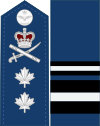
|
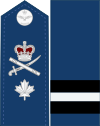
|

|

|

|

|

|

| |||||||||||||||
| General | Lieutenant-general | Major-general | Brigadier-general | Colonel | Lieutenant-colonel | Major | Captain | Lieutenant | Second lieutenant | |||||||||||||||
| Général(e) | Lieutenant(e)-général(e) | Major(e)-général(e) | Brigadier(ère)-général(e) | Colonel(le) | Lieutenant(e)-colonel(le) | Major(e) | Capitaine | Lieutenant(e) | Sous-lieutenant(e) | |||||||||||||||
Non-commissioned members
[edit]| NATO code | OR-9 | OR-8 | OR-7 | OR-6 | OR-5 | OR-4 | OR-3 | OR-2 | OR-1 | |||||||||||||||||||||||||||
|---|---|---|---|---|---|---|---|---|---|---|---|---|---|---|---|---|---|---|---|---|---|---|---|---|---|---|---|---|---|---|---|---|---|---|---|---|

|

|

|

|

|

|

|

| |||||||||||||||||||||||||||||
| Chief warrant officer | Master warrant officer | Warrant officer | Sergeant | Master corporal | Corporal | Aviator (trained) | Aviator (basic) | |||||||||||||||||||||||||||||
| Adjudant(e)-chef | Adjudant(e)-maître | Adjudant(e) | Sergent(e) | Caporal(e)-chef | Caporal(e) | Aviateur (formé)/ Aviatrice (formée) |
Aviateur (confirmé)/ Aviatrice (confirmée) | |||||||||||||||||||||||||||||
On 1 April 2015, the rank structure and insignia changed.[34] The rank of private was replaced with that of aviator, represented with a propeller for the rank insignia. The previously used term "leading aircraftman" was considered not to be gender neutral.[35] The rank insignia were also changed: enlisted ranks were changed from gold to pearl-grey (silver) and officers rank braid was changed from gold to pearl-grey on black, similar to the pattern used before unification of Canada's armed forces in 1968.[35] A revival of the former rank titles of the RCAF did not occur, however, as such an extensive change was considered "too complicated and confusing".[34] Instead, the current rank titles were retained (with the exception of aviator). The Royal Flying Corps, considered to be a predecessor of the RCAF, used rank titles similar to the existing rank titles of the RCAF.[35]
Symbols
[edit]Badge
[edit]The badge of the Royal Canadian Air Force consists of:[36]
- St. Edward's Crown
- An eagle superimposed on a circlet
- A compartment of maple leaves
- Motto: Sic Itur ad Astra (Latin for 'Such is the pathway to the stars')
Roundels
[edit]Roundels used from 1920 until 1945 were usually the same as Royal Air Force roundels although not all variations were used and colours were matched to locally available paints. On 5 July 1940, the RCAF was authorized to introduce the maple leaf into the roundel in place of the red centre. However, a large amount of RCAF planes still continued to use the RAF roundel until 1945 since their aircraft, including those built in Canada all came through RAF channels.[37][38]
-
1945–1946
-
1946–1965
-
Canadian Centennial
1967 variant -
1965–current
-
Current
low-vis
Stamps
[edit]On 9 November 1984, Canada Post issued "Air Force" as part of the Canadian Forces series. The stamps were designed by Ralph Tibbles, based on an illustration by William Southern. The 32¢ stamps are perforated 12 x 12.5 and were printed by Ashton-Potter Limited.[39]
See also
[edit]- List of aircraft of Canada's air forces
- Planned Canadian Forces projects
- Royal Canadian Air Force VIP aircraft
References
[edit]- ^ a b c d "Key facts". 30 September 2021. Retrieved 31 December 2021.
- ^ "Sic Itur ad Astra – Traditions Motto/Words". Archived 2013-05-22 at the Wayback Machine National Defence, 23 April 2009, Retrieved: 1 April 2013.
- ^ "DND/CAF Joint and Combined Space Program". Royal Canadian Air Force. 18 September 2020. Archived from the original on 22 October 2020.
- ^ Royal Canadian Air Force. "Royal Canadian Air Force - Mission". Her Majesty the Queen in Right of Canada as represented by the Minister of National Defence. Archived from the original on 6 March 2016. Retrieved 19 March 2016.
- ^ Berthiaume, Lee. "Air force's new name got lost in translation, documents show". Archived 2011-11-30 at Archive-It Postmedia News, 29 November 2011.
- ^ "Royal Canadian Air Force welcomes new Commander". National Defence News release. 12 August 2022. Retrieved 12 August 2022.
- ^ "Canadian Forces name". [1] CBC. Retrieved 26 September 2011.
- ^ Associated Press, "R.C.A.F. Founder Taken By Death", The Spokesman-Review, Spokane, Washington, Monday 3 January 1944, Volume 64, Number 134, page 2.
- ^ Roberts, Leslie. There Shall Be Wings. Toronto: Clark, Irwin and Co. Ltd., 1959. No ISBN. p. 33
- ^ Milberry, Larry, ed. Sixty Years—The RCAF and CF Air Command 1924–1984. Toronto: Canav Books, 1984. ISBN 0-9690703-4-9. p. 17
- ^ A History of Air Services in Canada Archived 2014-09-26 at the Wayback Machine Retrieved: 21 May 2014
- ^ Wise, Sydney F.; Douglas, William Alexander Binny (1980). The Official History of the Royal Canadian Air Force: The creation of a national air force. University of Toronto Press. p. 93.
- ^ Shores, Chirstopher F. (1984). History of the Royal Canadian Air Force. Royce Publciations. p. 20. ISBN 9780861241606.
- ^ a b Milberry, Larry (1984). Sixty years: The RCAF and CF Air Command 1924–1984. CANAV Books. ISBN 0969070349.
- ^ "Americans in the RCAF". Bomber Command Museum of Canada. 27 October 2017. Retrieved 17 July 2023.
- ^ Milberry, Larry, ed. (1984). Sixty Years—The RCAF and CF Air Command 1924–1984. Toronto: Canav Books. p. 97. ISBN 0-9690703-4-9.
- ^ "20-23 Lincoln's Inn Fields". Buildington. Retrieved 17 July 2023.
- ^ "Lincoln's Inn Fields in World War II (1939–45)". Friends of Lincoln's Inn Fields. 29 May 2019. Retrieved 28 June 2024.
- ^ "Canada's military contribution in Libya". CBC. 20 October 2011. Retrieved 28 September 2021.
- ^ Galloway, Gloria. "Conservatives to restore 'royal' monikers for navy, air force." Archived 2017-02-04 at the Wayback Machine The Globe and Mail, 15 August 2011. Retrieved: 26 September 2011.
- ^ Fitzpatrick, Meagan. "Peter MacKay hails 'royal' renaming of military." CBC News, 16 August 2011. Retrieved: 26 September 2011.
- ^ "Canada sending frigate to join NATO in eastern Europe|." Archived 2016-03-11 at the Wayback Machine The Globe and Mail, 1 May 2014.
- ^ a b c d e f g h i j k l m n o p q r s t u v w x y z aa ab ac ad ae af Hoyle, Craig (2023). "World Air Forces 2024". FlightGlobal. Retrieved 22 March 2024.
- ^ "Canadian Forces Briefing on UAVs". COPA Flight 8. June 2009. Archived from the original on 11 July 2012. Retrieved 30 June 2009.
- ^ Department of National Defence (19 December 2023). "Canada acquiring Remotely Piloted Aircraft Systems for the Canadian Armed Forces". Government of Canada News. Retrieved 3 May 2024.
- ^ "QinetiQ Wins C$51m Contract with the Canadian Armed Forces' Unmanned Aircraft System Service program". Umsskeldar.aero. Retrieved 22 May 2019.[permanent dead link]
- ^ "CF-188 Hornets on Op MOBILE drop first JDAM bombs." Archived 2012-03-08 at the Wayback Machine Forces.gc. Retrieved: 2 February 2012.
- ^ "FrontLine". FrontLine Defence Magazine Canada. Archived from the original on 17 January 2021. Retrieved 27 July 2022.
- ^ Skaarup, Harold (16 November 2009). Canadian Warplanes. iUniverse. pp. 279–283. ISBN 978-1440167584. Retrieved 7 September 2022.
- ^ "Disposal of Rockeye Cluster Bombs at CFAD Dundurn." National Defence and the Canadian Forces, 27 July 2004. Retrieved: 26 September 2011.
- ^ "3 Canadian Space Division - Royal Canadian Air Force". www.canada.ca. 22 July 2022. Retrieved 29 September 2023.
- ^ a b "Ranks and appointment". canada.ca. Government of Canada. Retrieved 28 May 2021.
- ^ a b "The Canadian Armed Forces modernizes military ranks in French". Canada. Government of Canada. 3 February 2022. Retrieved 7 April 2024.
- ^ a b "New Royal Canadian Air Force uniform unveiled." Archived 2014-09-24 at the Wayback Machine CTV Ottawa1 April 2015.
- ^ a b c "DND Backgrounder." Archived 2014-12-18 at the Wayback Machine news.gc.ca, April 2015.
- ^ "Approval of a Badge". Public Register of Arms, Flags and Badges of Canada. Official website of the Governor General. Retrieved 8 November 2021.
- ^ https://www.canada.ca/en/department-national-defence/services/military-history/history-heritage/official-military-history-lineages/customs-traditions/distinguishing-marks.html [bare URL]
- ^ "Origin of the Roundel".
- ^ "Canada Post stamp." Collections Canada. Retrieved: 23 October 2012.
Further reading
[edit]- Douglas, W. A. B. The Creation of a National Air Force: Official History of the Royal Canadian Air Force, v. 2. Toronto: University of Toronto Press (in co-operation with the Department of National Defence), 1986. ISBN 0-8020-2584-6.
- Green, William & Swanborough, Gordon (February–May 1979). "A Grumman by Any Other Name...". Air Enthusiast (9): 26–39. ISSN 0143-5450.
- Milberry, Larry, ed. Sixty Years: The RCAF and CF Air Command 1924–1984. Toronto: Canav Books, 1984. ISBN 0-9690703-4-9.
- Piggott, Peter. Flying Canucks: Famous Canadian Aviators. Toronto: Hounslow Press, 1996. ISBN 0-88882-175-1.
- Piggott, Peter. Flying Canucks II: Pioneers of Canadian Aviation. Toronto: Hounslow Press, 1997. ISBN 0-88882-193-X.
External links
[edit]- Official website

- Canadian Air Force aircraft and equipment of Canada(Air recognition)
- "Roundel Round-Up" – Vintage Wings of Canada's history of British and Canadian roundel styles from 1914 through and into the 21st century Archived 2015-04-03 at the Wayback Machine
- The Royal Canadian Air Force in the Arctic and Sub-Arctic Manuscript at Dartmouth College Library










